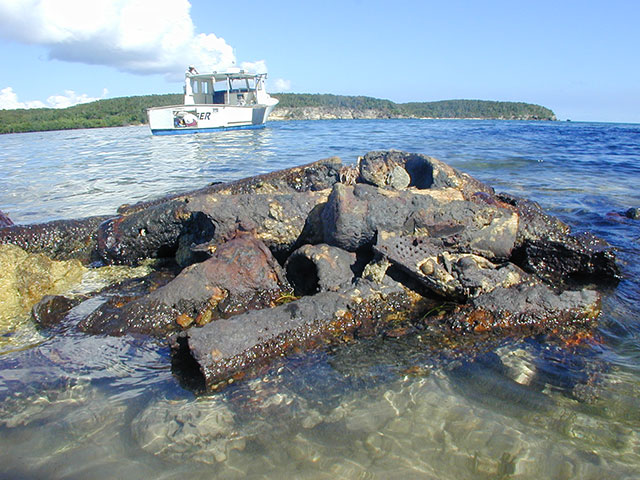
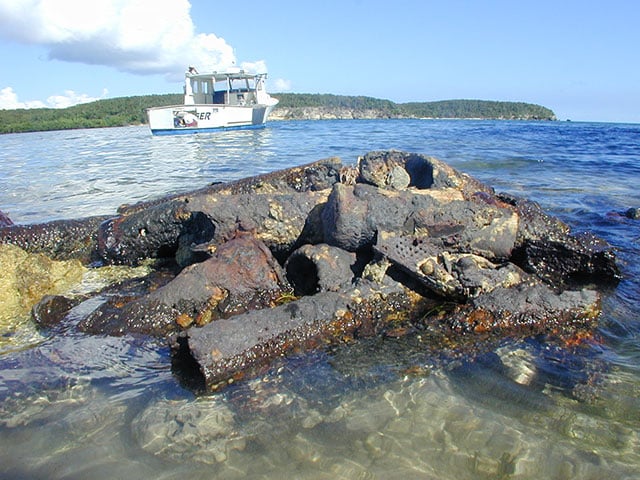 Recoil-less rifle cartridges on the north shore of the Island of Vieques, Puerto Rico. According to a recent study, some fish and shellfish from certain reefs surrounding Vieques contained elevated levels of metals like arsenic and selenium. (Photo: Courtesy of James Barton)
Recoil-less rifle cartridges on the north shore of the Island of Vieques, Puerto Rico. According to a recent study, some fish and shellfish from certain reefs surrounding Vieques contained elevated levels of metals like arsenic and selenium. (Photo: Courtesy of James Barton)
By 1972, when the US officially ended its practice of dumping munitions out to sea, tens of thousands of tons of chemical weapons, conventional munitions and radioactive wastes had been disposed of in the Atlantic Ocean, the Pacific Ocean, and the Gulf of Mexico at sites up and down the nation’s coastlines, including Alaska, Hawaii and the Caribbean.
In the decades that followed, little was done to reckon with the problems these sites presented. Until finally, in 2006, Congress directed the Department of Defense (DoD) to conduct a multi-pronged study to finally figure out just how many chemical and conventional munitions were slowly degrading in US coastal waters, and whether it was feasible to retrieve these munitions from their watery graves. Congress also ordered the DoD to examine the ecological impact from toxic emissions as these munitions slowly corrode under water, and their potential to cause harm to the people who use the oceans — like fishermen, whose nets become entangled with old obsolete bombs as they dredge the sea floor.
In a report to Congress in November of last year, the DoD made its final determination. From both an ecological and safety perspective, it was deemed best to “leave sea-disposed munitions in place,” the department found. It stated that removing or cleaning up munitions sea-disposal dump sites would have “more serious effects on marine life and the ocean environment than would leaving them in place.”
“Utter Nonsense”
The DoD’s plan to leave the munition dump sites untouched is “utter nonsense” and a decision driven by “economics, not legitimate science,” wrote James Barton, a federally recognized munitions expert, in a statement to Truthout.
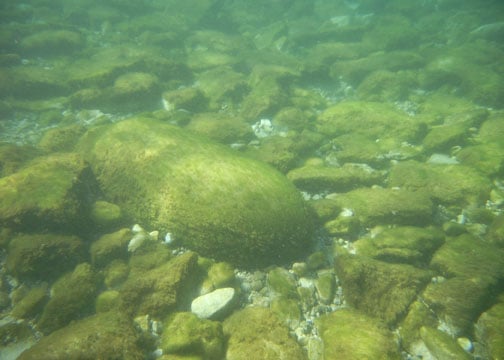 A 1,000 lb general purpose bomb found in Lake Michigan, in vicinity of the Waugoshance Lighthouse, once used as a bombing target during WWII. (Photo: Courtesy of James Barton)Barton co-authored a report commissioned by the Center for Disease Control (CDC) and its National Center for Environmental Health, published earlier this year, which offers a damning commentary on the Pentagon’s approach to tackling the nation’s underwater munitions problem. The department’s decision, wrote Barton, sets a “dangerous” precedent for hundreds of dump sites around the country. “DoD has no institutional or moral authority to keep the potential threat presented by underwater munitions from being properly assessed, but seem forever committed to that ruse,” he wrote.
A 1,000 lb general purpose bomb found in Lake Michigan, in vicinity of the Waugoshance Lighthouse, once used as a bombing target during WWII. (Photo: Courtesy of James Barton)Barton co-authored a report commissioned by the Center for Disease Control (CDC) and its National Center for Environmental Health, published earlier this year, which offers a damning commentary on the Pentagon’s approach to tackling the nation’s underwater munitions problem. The department’s decision, wrote Barton, sets a “dangerous” precedent for hundreds of dump sites around the country. “DoD has no institutional or moral authority to keep the potential threat presented by underwater munitions from being properly assessed, but seem forever committed to that ruse,” he wrote.
The DoD will now leave in place massive amounts of underwater munitions in US coastal waters. These munitions include over 32,000 tons of chemical weapons containing things like lewisite (a blister agent and lung irritant), mustard gas, sarin and the nerve agent VX, according to a 2009 DoD report. The same report identifies 47 individual dump sites along the coastlines of the continental US.
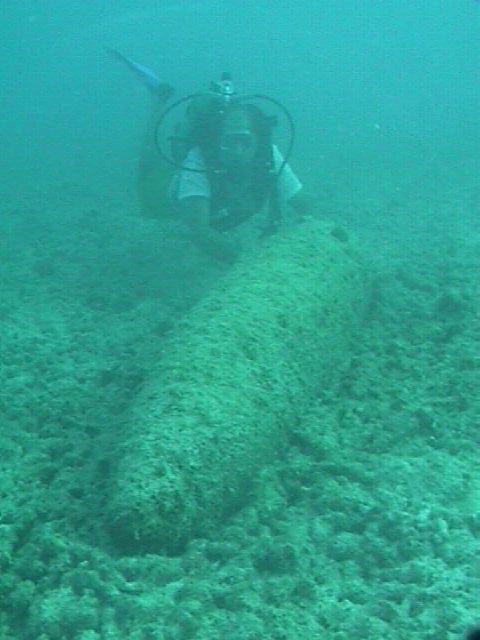 An underwater bomb on the south side of Vieques Island, Puerto Rico. HMX and trace levels of RDX explosive compounds were found in fiddler crabs surrounding Vieques, according to a recent report. (Photo: Courtesy of James Barton)These sites contain a combination of chemical munitions, conventional munitions and radioactive wastes, and they vary in proximity to the coast — some less than a mile from shore, others as far as a few hundred nautical miles away. At one dump site within the Chesapeake Bay, an unknown quantity of explosives sits roughly two nautical miles from the shoreline. At another site some nine nautical miles from the Massachusetts coastline, thousands of projectiles lie 200 feet below the sea surface. Over on the west coast, more than 300,000 mustard gas bombs and nearly 1,500 containers of lewisite sit at a dump site roughly 100 nautical miles from the Northern California shore.
An underwater bomb on the south side of Vieques Island, Puerto Rico. HMX and trace levels of RDX explosive compounds were found in fiddler crabs surrounding Vieques, according to a recent report. (Photo: Courtesy of James Barton)These sites contain a combination of chemical munitions, conventional munitions and radioactive wastes, and they vary in proximity to the coast — some less than a mile from shore, others as far as a few hundred nautical miles away. At one dump site within the Chesapeake Bay, an unknown quantity of explosives sits roughly two nautical miles from the shoreline. At another site some nine nautical miles from the Massachusetts coastline, thousands of projectiles lie 200 feet below the sea surface. Over on the west coast, more than 300,000 mustard gas bombs and nearly 1,500 containers of lewisite sit at a dump site roughly 100 nautical miles from the Northern California shore.
What’s more, old abandoned ordnances don’t always stay where they’re dumped. In recent years, a number of chemical and conventional munitions have washed ashore, while some fishermen have been harmed after coming into contact with chemical munitions pulled up in nets.
According to Terrance Long, chair and CEO of the International Dialogue on Underwater Munitions in The Hague, and a leading expert in underwater munition dumps worldwide, what the DoD has identified is only the tip of the iceberg, and he estimates that there could be as many as 1,000 separate dump sites in the coastline surrounding the continental US.
“As we continue to survey the ocean, we continue to find more,” Long said, noting that one undocumented dump site near the California coastline is suspected to contain more than 200 scuttled ships loaded with munitions. “What you have is a desktop study conducted by the United States that had limitations to it, so it’s a cursory look into what’s out there,” he said.
Truthout contacted the CDC and the DoD for comment, but neither agency responded in time for publication.
Incomplete Research
The DoD’s 2009 report identifies seven sites surrounding Alaska, two around Puerto Rico and six individual sites around Hawaii, including two off the coast of the island of Oahu. These two sites near Oahu were selected as areas for study to determine whether they and other underwater munition dump sites in US coastal waters should be remediated.
 An underwater munition dump site. According to the DoD, there are at least 32,000 tons of chemical weapons dumped in U.S. coastal waters. (Photo: Courtesy of the International Dialogue on Underwater Munitions)Using the evidence collected, the DoD determined in its report to Congress last year that known sea-disposal sites “do not pose an unacceptable risk to ecological, environmental, or human health or to maritime safety.”
An underwater munition dump site. According to the DoD, there are at least 32,000 tons of chemical weapons dumped in U.S. coastal waters. (Photo: Courtesy of the International Dialogue on Underwater Munitions)Using the evidence collected, the DoD determined in its report to Congress last year that known sea-disposal sites “do not pose an unacceptable risk to ecological, environmental, or human health or to maritime safety.”
But the CDC report finds major flaws in the research as it relates to other munition dump sites — primarily with the choice of research areas, and how the detection technologies used can produce “ambiguous results.” If the DoD had instead investigated the nearby Barbers Point Ammo Dump, where munitions are much more heavily concentrated than in the chosen research sites, the scope of the findings would have afforded officials a more accurate picture with which to make an “informed decision” about whether to remediate underwater munitions across the US coastline, the report concluded.
Margo Edwards is interim executive director of the Applied Research Laboratory at the University of Hawaii, and is one of the scientists who researched the Hawaii Undersea Military Munitions Assessment (HUMMA) dump site to the south of the island of Oahu. Her team only received funding to study this site alone, and their findings suggest that the DoD is right to leave the munitions in place at the HUMMA site, said Edwards: “You can only go by the evidence you have to hand, and the evidence I see right now says that that’s the right decision.” But she admitted that a lack of studies conducted on the other munition dump sites in US waters makes it difficult to accurately determine if and how they, too, should be remediated.
“I haven’t investigated all these other potential areas,” Edwards said. “And I do think it’s possible that there could be another place where the problem needs to be addressed differently.”
Other experts agree that there simply hasn’t been enough research done on underwater munitions.
“I don’t think Hawaii is a surrogate for the rest of the US or even the world,” said Harry Craig, a senior remedial project manager for the US Environmental Protection Agency, with 15 years expertise in underwater munitions under his belt. He explains that chemicals break down and react differently in different environments. Plus, steel corrodes at different rates depending on water depth, salinity and temperature, as well as shell thickness. Some sea-dumped munitions could continue leaking potentially deadly chemicals into the environment for over 100 years, according to some estimates.
“We’ve seen [munitions] that you can still read the writing on them from 1944, and then you’ve got ones that are substantially wasted and falling apart,” said Craig, emphasizing why each site needs to be looked at on an individual basis.
Many Munitions Locations Are Still Unknown
The official green light for the US military to start dumping munitions out to sea was given back in 1917. Rules regarding the location and depth of disposal sites were incrementally tightened over the following decades. The War Department in 1944, for example, required that chemical weapons be disposed of in waters at least 300 feet deep and 10 miles from shore. One year later, chemical weapons weren’t to be disposed of in waters shallower than 6,000 feet. For conventional explosives and ammunition, it was 3,000 feet.
The ocean dumping of munitions accelerated after the end of World War II, when the War Department was left to reckon with a massive stockpile of wartime weapons and bombs. One way they approached the problem was the “Cut Holes and Sink ‘Em” disposal program (coined CHASE), which saw old ships loaded up with tons of conventional and chemical weapons before being scuttled out to sea. But 1969 marked a change in policy direction, when the National Academy of Sciences was asked to study the problem and look at alternative munition disposal practices. In 1972, Congress banned the practice. Then, three years later, the US signed an international treaty prohibiting the dumping of chemical weapons in ocean waters.
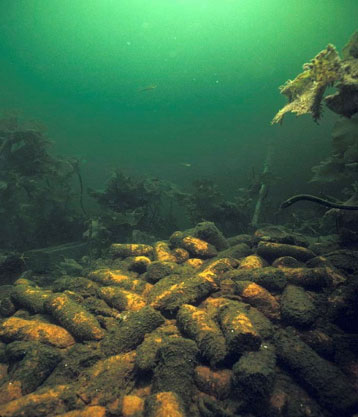 An underwater munition dump site. According to Terrance Long, chair and CEO of the International Dialogue on Underwater Munitions in the Hague, there could be as many as 1000 separate dump sites in the coastline surrounding the continental U.S., many of them currently undocumented. (Photo: Courtesy of the International Dialogue on Underwater Munitions)
An underwater munition dump site. According to Terrance Long, chair and CEO of the International Dialogue on Underwater Munitions in the Hague, there could be as many as 1000 separate dump sites in the coastline surrounding the continental U.S., many of them currently undocumented. (Photo: Courtesy of the International Dialogue on Underwater Munitions)
The damage, however, had already been done. For one, the military proved to be a poor record keeper: Its archives are full of holes. “Is there a complete inventory of where this stuff is? No there isn’t,” said Craig. “They were trying to get rid of this stuff, and they were trying to do the least amount of paperwork.”
Nor did those tasked with doing the dumping always stick to the rules. As John Chatterton, a veteran diver and former host of the History Channel’s “Deep Sea Detectives,” put it in a well-received 2005 Daily Press investigative series on underwater munitions, “the guys who were doing this were scared of this stuff…. They were well motivated to get rid of this stuff as fast as they could. So, they could take it all the way out there or else they could say, ‘This is good enough,’ and be back in port in three hours. I know what they did. It’s mariner nature.”
These lingering question marks surrounding the accurate location of existing dump sites is another reason why some experts argue that the DoD is wrong to leave dump sites uniformly untouched, especially given the number of recent examples where the public has come into contact with ordnances abandoned at sea.
In August of last year, a fisherman working along the New Jersey coast was hospitalized with second-degree burns from an old chemical munition he pulled up. Nearly 700 cases of clam chowder were destroyed, for fear of contamination. In 2015, two old artillery shells suspected of containing mustard gas appeared at a Delaware seafood processing plant. In 2010, clam fishermen working off the New York coastline dredged up two munition shells containing mustard gas, severely sickening the crew.
Only this month, two unexploded munitions washed up on a North Carolina beach — reportedly the third time this has happened this year.
“There’s a concern in some of these places that intact shells may in fact be time bombs in the sense that they’re well contained but eventually they will corrode, and we don’t know what will happen to them,” said Lenny Siegel, executive director of the Center for Public Environmental Oversight and an expert in military cleanups. “That would involve a site-specific evaluation.”
Advocates Seek Further Investigation
Beyond ocean dumping, experts point to a lack of action concerning munitions dumped in bodies of water — ponds, lakes, rivers and estuaries — within the continental US, from activities like shore-based gunnery practice, research activities and ship and aerial bombardment. A combination of high cleanup costs and lack of adequate oversight explain why the DoD has failed to remediate these sites, said Steve Pollack, an Illinois licensed attorney who co-authored the CDC report published earlier this year. “It costs money from its budget to assess and retrieve munitions,” he said, arguing that the DoD has been historically reluctant to funnel adequate funds into environmental cleanup programs.
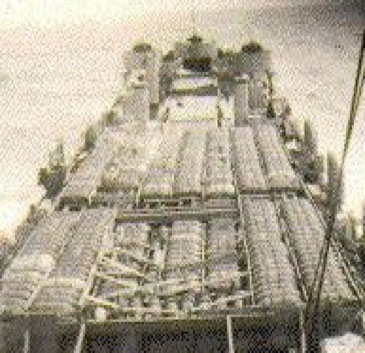 Archival picture of a ship loaded with munitions, awaiting scuttling out to sea. (Photo: Courtesy of the International Dialogue on Underwater Munitions / National Archives)In the report, Pollack pinpoints some known mainland underwater dump sites, including a number within the Great Lakes, which have long been used to dispose of conventional and radiological wastes. Lead contamination from artillery fired from an FBI firing range into Lake Michigan threatens municipal drinking water in the area, the report finds. Meanwhile, approximately 300,000 munitions fired from the Erie Army Depot cover some 8,000 acres at the bottom of Lake Erie.
Archival picture of a ship loaded with munitions, awaiting scuttling out to sea. (Photo: Courtesy of the International Dialogue on Underwater Munitions / National Archives)In the report, Pollack pinpoints some known mainland underwater dump sites, including a number within the Great Lakes, which have long been used to dispose of conventional and radiological wastes. Lead contamination from artillery fired from an FBI firing range into Lake Michigan threatens municipal drinking water in the area, the report finds. Meanwhile, approximately 300,000 munitions fired from the Erie Army Depot cover some 8,000 acres at the bottom of Lake Erie.
Within the DoD’s Formerly Used Defense Sites program — tasked with cleaning up former DoD properties — there are potentially more than 400 sites containing underwater munitions totaling more than 10 million acres, according to an internal 2010 white paper. The US Navy and US Marine Corps identified an additional 33 sites containing underwater munitions.
“We, the public, learn of existing sites once someone comes in contact with dangerous munitions,” said Pollack. He added that the public should be concerned about the contaminants that make up unexploded munitions, “especially because the Great Lakes are the source of fresh drinking water for all the people around them.”
Then there’s the potential toxicological impact from leaking munitions on the surrounding ecosystems. According to the DoD, research from the two Hawaiian dump sites indicates that the munitions “were not destroying habitat,” and have become an “integral part of the environment.” But published research coming out of Hawaii paints a more nuanced picture. One study conducted at the HUMMA site shows that mustard agent remains in the deep-marine environment for decades after munitions disposal.
Other studies corroborate these findings. Take the island of Vieques, in Puerto Rico. The waters around Vieques are littered with munitions. Some fish and shellfish from certain reefs surrounding the island contain elevated levels of metals like arsenic and selenium, while HMX and trace levels of RDX explosive compounds were found in fiddler crabs, according to a recent report. Also, tests conducted on cod caught in the Baltic Sea suggests a link between chemical weapon dump sites and an increased likelihood of disease in the fish. And white phosphorus, which is found in many incendiary devices routinely dumped to sea, has been reported in many coastal areas around the world.
This interactive map put together by the James Martin Center for Nonproliferation Studies shows chemical weapon dumps sites worldwide.
“It’s highly improbable that these sites won’t have an impact,” said Terrance Long, who added that toxic emissions from leaking munitions are one potential factor determining why whales and dolphins are being killed en masse in otherwise inexplicable circumstances. Plus, the seismic testing of the ocean floor conducted during oil and gas exploration has the potential to trigger abandoned explosives — another reason to clear the seas of abandoned ordnances, he said.
“All we’ve shown is that we have a problem and that we have to further investigate it,” Long said, about the research the DoD has conducted over the past decade. “You either believe that the underwater munitions can actually have an impact on the ocean, or you believe they don’t, just like climate change. But it’s about now getting to the table to have the discussion that needs to happen.”
Defying Trump’s right-wing agenda from Day One
Inauguration Day is coming up soon, and at Truthout, we plan to defy Trump’s right-wing agenda from Day One.
Looking to the first year of Trump’s presidency, we know that the most vulnerable among us will be harmed. Militarized policing in U.S. cities and at the borders will intensify. The climate crisis will deteriorate further. The erosion of free speech has already begun, and we anticipate more attacks on journalism.
It will be a terrifying four years to produce social justice-driven journalism. But we’re not falling to despair, because we know there are reasons to believe in our collective power.
The stories we publish at Truthout are part of the antidote to creeping authoritarianism. And this year, we promise we will kick into an even higher gear to give you truthful news that cuts against the disinformation, vitriol, hate and violence. We promise to publish analyses that will serve the needs of the movements we all rely on to survive the next four years, and even build for the future. We promise to be responsive, to recognize you as members of our community with a vital stake and voice in this work.
Please show your support for Truthout with a tax-deductible donation (either once today or on a monthly basis).